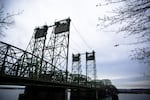
FILE: The Interstate 5 bridge connecting Washington and Oregon across the Columbia River as seen from Vancouver, Washington, Saturday, Dec. 15, 2018.
Bradley W. Parks / OPB
The Interstate 5 Bridge will raise up again soon — but not for a bridge lift.
Planners for the effort to replace the aging span revealed Wednesday that it is going to be more expensive than previously thought. Program leader Greg Johnson didn’t put a number on the growing price tag, but he said the replacement project is falling victim to a “continuing creep of costs.”
“One of the things all mega projects are experiencing is this inflation we’ve seen in the construction industry,” Johnson said. “We are going to be reissuing an overall program estimate probably later this summer.”
Johnson, who leads the planning team that is jointly funded by Oregon and Washington’s departments of transportation, made the statement while hosting a visit from Washington’s U.S. Sens. Patty Murray and Maria Cantwell.
The two federal delegates arrived Wednesday to tour the bridge, just weeks after they helped secure $600 million in federal grants to pay for the replacement.
Planners had said in December 2022 the cost would land between $5 billion and $7.5 billion — itself an upward revision from projected costs in 2020. Planners in the past year have said they were aiming for a $6 billion total cost. Johnson couldn’t specify the latest estimate Wednesday when asked by reporters at the event.
“We don’t have those numbers as of yet. Our team is working on putting together everything that has changed,” Johnson said. “So, we’re going to be looking at what has changed in between now and then, what risk elements have gone up — what’s happening in the industry.”
Johnson laid the blame on construction costs.
In its entirety, the project aims to reconstruct 11 miles of road where Oregon and Washington meet. Besides replacing the bridge, the effort would build a new span connecting north Portland with Hayden Island, as well as rebuild seven interchanges.
Many elements haven’t been finalized, such as how many lanes and auxiliary lanes a new bridge could include and whether it will continue to have a lift for tall shipments on the Columbia River. Planners have floated multiple options that remain under consideration.
When asked if designs could be impacted by rising costs, Johnson spoke generally about “value engineering.”
“We’re going to be looking at everything that’s within that corridor (of the project),” he said. “That’s where you bring in other national experts to look at what you are proposing and they will give you ideas on how they think you can reduce costs.”
The cost is important as the project gets further along.
Lawmakers from both states first met on this latest incarnation in 2018. The last attempt to replace the project famously fell flat in 2013 when Washington state declined to help pay for it.
Johnson and his team have banked on getting three main sources of funding to pay for the new bridge: money from Oregon and Washington, federal grant money, and tolls collected from drivers using the bridge.
Until costs are final, it won’t be clear how large of a pie-slice each of those funding sources will be.
Oregon and Washington state have pledged $1 billion each. And, in December, the U.S. Department of Transportation agreed to kick in $600 million — a windfall that at least partly spurred Cantwell and Murray’s visit.
Planners have said they hope to get as much as $2.5 billion total from the federal government. They recently applied for a $1.5 billion grant from the Federal Highway Administration.
Murray, on Wednesday, said the delegates plan to do “everything we can to try and meet the estimate of what we need.” She noted that people have talked about replacing the bridge since she first arrived in Washington, D.C., in 1992 and costs have only risen.
“Yes, prices have increased, inflation has increased, this project is not going to get any cheaper, and that bridge is not going to get any safer,” Murray said. “We’re going to do everything we can to make sure that we meet the goals that we can.”
The recent payment from the U.S. Department of Transportation should instill some confidence, Cantwell said. She noted that the federal government, through recent infrastructure bills, has made available an unprecedented amount of federal money.
“They’re in, now. Once they’re in, they’re going to want to see it done,” Cantwell said. “They’ve already said, ‘We like this project.’ So my sense is we’ll get money out of the bridge fund and some other investments.”